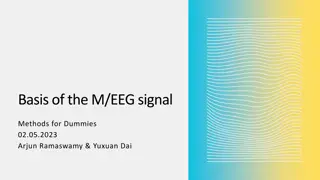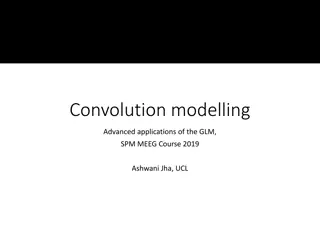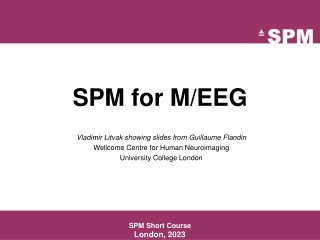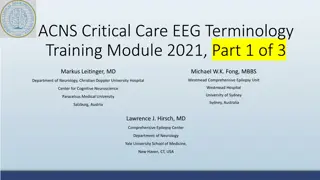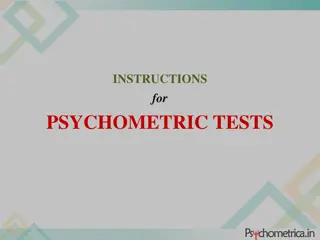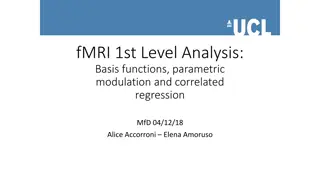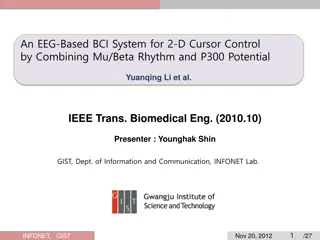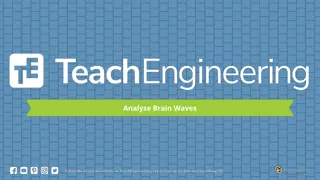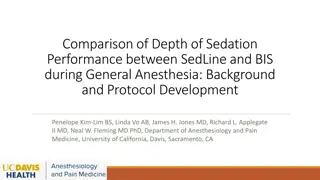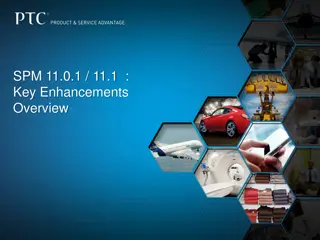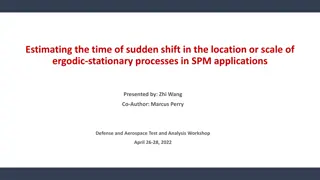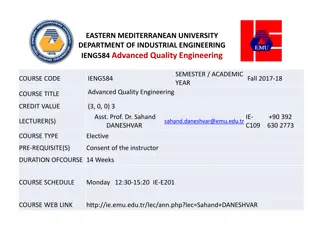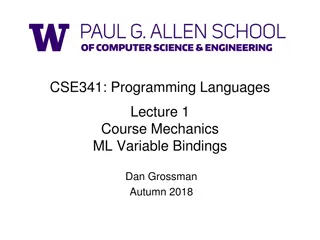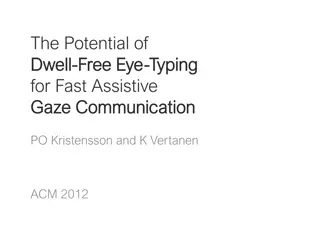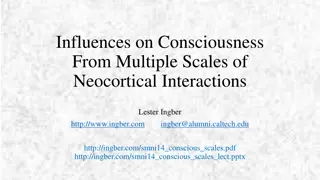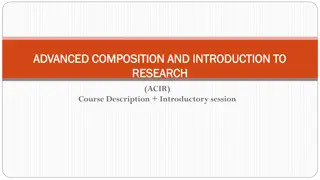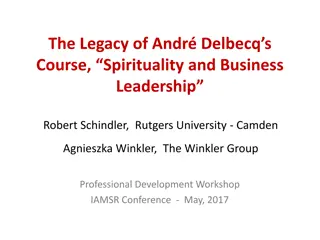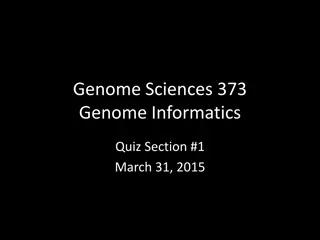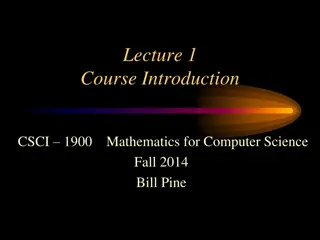Advanced Applications of GLM and SPM in M/EEG Course 2018
This course delves into utilizing Convolution GLM to address challenges such as baseline correction, overlapping neural responses, and systematic response timing differences in EEG experiments. It focuses on the stop-signal task, EEG correlates of movement stopping, and MEG data analysis. The course aims to highlight the neural correlates of successful stop-signals and introduces trial-based methods to explore these correlates effectively.
Download Presentation

Please find below an Image/Link to download the presentation.
The content on the website is provided AS IS for your information and personal use only. It may not be sold, licensed, or shared on other websites without obtaining consent from the author. Download presentation by click this link. If you encounter any issues during the download, it is possible that the publisher has removed the file from their server.
E N D
Presentation Transcript
Convolution modelling Advanced applications of the GLM, SPM MEEG Course 2018 Vladimir Litvak, UCL (standing in for Ash Jha)
Outline Experimental Scenario (stop-signal task) Difficulties arising from experimental design Baseline correction Temporally overlapping neural responses Systematic differences in response timings Using a convolution GLM to deal with these problems* *just like first level fMRI
What is the problem were trying to address? Baseline correction Temporally overlapping neural responses Systematic differences in response timings ... an example
The task: stop-signal task What is the EEG correlate of stopping a planned movement ? Parameterise behaviour: stop-signal task Record neural activity: MEG Behavioural contrast of interest: Isolate stopping Apply equivalent contrast to MEG data MEG correlate of stopping
The task: stop-signal task GO trial STOP trial + trial n+1 + trial n < X > Go signal Go signal Stop signal SOA time time X response response Error Correct
What is the neural correlate of a successful stop-signal? TF MEG + + + > > > + > + + > > X Correct + + + > > > X + > + + > > Error
What is the neural correlate of a successful stop-signal? TF MEG + + + > > > + > + + > > X Correct + + + > > > X + > + + > > Error A: Trial-based method 1) Cut into trials 2) Average response over trials 3) Compare with another trial
M1l M1r SMA preSMA rIFG lIFG 80 80 80 80 80 80 Frequency (Hz) 60 60 60 60 60 60 40 40 40 40 40 40 20 20 20 20 20 20 0 1 0 1 0 1 0 1 0 1 0 1 What is the neural correlate of a successful stop-signal? 80 80 M1l M1r SMA preSMA rIFG lIFG 80 80 80 80 Frequency (Hz) 60 60 60 60 60 60 40 40 40 40 40 40 TF MEG 20 20 20 20 20 20 + + + > > > Time (s) 0 1 Time (s) 0 1 Time (s) 0 1 Time (s) 0 1 Time (s) 0 1 Time (s) 0 1 + > + + > > X Correct + + + > > > X + > + + > > Error A: Trial-based method All sorts of problems: 1) Cut into trials 2) Average response over trials 3) Compare with another trial 1) Temporally overlapping neural responses 2) Where do you put the baseline? 3) Variable (absent) response timings
How do we address these problems? Baseline correction Temporally overlapping neural responses Systematic differences in response timings ... A convolution model?
Concept of convolution model TF MEG > > + + + + X X All trials + > X PST
Concept of convolution model TF MEG > > + + + + X X All trials + > X X PST Accounts for temporally overlapping responses and differences in response timings (beware of correlation)
The Convolution model (half way) + X Y At different frequencies
The Convolution model (full model) * Note baseline drift
Simulationresults Condition 1 mean(RT) = 300ms Condition 2 mean(RT) = 600ms std(RT) = 125ms There is no true difference in amplitude, but there appears to be one because of consistent difference in the reaction time
Simulationresults Contrast T Significance GLM Frequency (Hz) avg Time (msec) Design: all ERDs were modelled as a single condition. ERSs were omitted for half of the trials (randomly selected).
What about the opposite case? The opposite case Condition 1 mean(RT) = 300ms Condition 2 mean(RT) = 600ms std(RT) = 125ms Amplitude of response to stimulus in condition 1 was adjusted to be (almost) the same as in condition 2 in the average. So here there is true difference in the amplitude that is obscured due to the difference in reaction time.
The opposite case Contrast T Significance GLM Frequency (Hz) avg Time (msec)
Example output of convolution model M1l M1r SMA preSMA rIFG lIFG M1l M1l 80 80 80 80 80 80 0.2 Frequency (Hz) GO signal 60 60 60 60 60 60 80 80 0.15 40 40 40 40 40 40 RMS amplitude (a.u.) 0.1 0.1 Frequency (Hz) Frequency (Hz) 20 20 20 20 20 20 60 60 0.05 0 1 0 1 0 1 0 1 0 1 0 1 0 0 40 40 M1l M1r SMA preSMA rIFG lIFG -0.05 80 80 80 80 80 80 -0.1 Frequency (Hz) -0.1 20 20 60 60 60 60 60 60 Button press -0.15 40 40 40 40 40 40 -0.2 0 1 0 1 20 20 20 20 20 20 Time (s) 0 1 0 1 0 1 0 1 0 1 0 1 Time (s) Time (s) Time (s) Time (s) Time (s) Time (s)
Heirarchical model analysis First-level convolution model Subject > SMA + M1r X M1l preSMA rIFG lIFG 80 80 80 80 80 80 Frequency (Hz) 60 60 60 60 60 60 1 40 40 40 40 40 40 20 20 20 20 20 20 0 1 0 1 0 1 0 1 0 1 0 1 M1l M1r SMA preSMA rIFG lIFG 80 80 80 80 80 80 M1l M1r SMA preSMA rIFG lIFG Frequency (Hz) 80 60 80 60 80 60 80 60 80 60 80 60 Frequency (Hz) 60 40 60 40 60 40 60 40 60 40 60 40 2 40 20 40 20 40 20 40 20 40 20 40 20 20 20 20 20 20 20 0 1 0 1 0 1 0 1 0 1 0 1 Time (s) Time (s) Time (s) Time (s) Time (s) Time (s) 0 1 0 1 0 1 0 1 0 1 0 1 M1l M1l M1r M1r SMA SMA preSMA preSMA rIFG rIFG lIFG lIFG 80 80 80 80 80 80 80 80 80 80 80 80 Frequency (Hz) 60 60 60 60 60 60 60 60 60 60 60 60 Frequency (Hz) 40 40 40 40 40 40 40 40 40 40 40 40 3 20 20 20 20 20 20 20 20 20 20 20 20 0 1 1 0 1 1 0 1 1 0 1 1 0 1 1 0 1 1 Time (s) 0 Time (s) 0 Time (s) 0 Time (s) 0 Time (s) 0 Time (s) 0 M1l M1r SMA preSMA rIFG lIFG 80 80 80 80 80 80 Frequency (Hz) 60 60 60 60 60 60 40 40 40 40 40 40 20 20 20 20 20 20 0 1 0 1 0 1 0 1 0 1 0 1 Time (s) Time (s) Time (s) Time (s) Time (s) Time (s)
Heirarchical model analysis Take contrasts of interest to second level First-level convolution model Subject M1l M1r SMA preSMA rIFG lIFG 80 80 80 80 80 80 > SMA SMA > + M1r X Frequency (Hz) 60 60 60 60 60 60 M1l preSMA rIFG lIFG 40 40 40 40 40 40 M1l M1r preSMA rIFG lIFG 80 80 80 80 80 80 80 80 80 80 80 80 20 20 20 20 20 20 Frequency (Hz) 60 Frequency (Hz) 60 60 60 60 60 60 60 60 60 60 60 1 SMA 20 > 0 1 0 1 0 40 1 0 1 0 1 0 1 40 40 40 40 40 40 40 40 40 40 40 20 20 20 20 20 20 20 20 M1l 20 M1r 20 preSMA 20 rIFG lIFG 0 1 0 1 0 1 0 1 0 1 0 1 0 1 0 80 1 0 80 1 0 1 0 1 0 1 80 80 80 80 Frequency (Hz) M1l M1r SMA preSMA rIFG lIFG M1l M1r SMA preSMA rIFG lIFG 60 60 60 60 60 60 80 80 80 80 80 80 M1l M1r SMA preSMA rIFG M1l lIFG M1r SMA preSMA rIFG lIFG 80 80 80 80 80 80 40 40 40 40 40 40 Frequency (Hz) 80 60 Frequency (Hz) 80 60 80 60 80 60 80 60 60 80 80 60 60 80 60 80 60 80 60 80 60 80 Frequency (Hz) Frequency (Hz) 20 20 20 20 20 20 60 40 60 40 60 40 60 40 60 40 40 60 60 40 40 60 40 60 40 60 40 60 40 60 2 40 20 40 20 40 20 40 20 40 20 20 40 40 20 20 40 20 40 20 40 40 20 40 0 20 0 1 0 1 1 0 1 0 1 0 1 Time (s) 20 Time (s) 20 Time (s) 20 Time (s) 20 Time (s) Time (s) 20 20 20 20 20 20 20 20 0 1 0 1 0 1 0 1 0 1 0 1 0 1 0 1 0 1 0 1 0 1 0 1 Time (s) Time (s) Time (s) Time (s) Time (s) Time (s) 0 Time (s) Time (s) 0 Time (s) 0 Time (s) 0 Time (s) 0 Time (s) 0 0 1 0 1 0 1 0 1 0 1 1 0 1 1 1 1 1 1 M1l M1l M1r M1r SMA SMA preSMA preSMA rIFG rIFG M1l M1l lIFG lIFG M1r M1r SMA SMA preSMA preSMA rIFG rIFG lIFG lIFG 80 80 80 80 80 80 80 80 80 80 Frequency (Hz) 80 80 80 80 80 80 80 80 80 80 80 80 80 80 Frequency (Hz) 60 60 60 60 60 60 60 60 60 60 60 60 60 60 60 60 60 60 60 60 60 60 60 60 Frequency (Hz) Frequency (Hz) 40 40 40 40 40 40 40 40 40 40 40 40 40 40 40 40 40 40 40 40 40 40 40 40 3 20 20 20 20 20 20 20 20 20 20 20 20 20 20 20 20 20 20 20 20 20 20 20 20 0 1 1 0 1 1 0 1 1 0 1 1 0 0 1 1 1 1 0 0 1 1 1 1 0 1 1 0 1 1 0 1 1 0 1 1 Time (s) 0 Time (s) 0 Time (s) 0 Time (s) 0 Time (s) 0 Time (s) 0 Time (s) 0 Time (s) 0 Time (s) 0 Time (s) 0 Time (s) 0 Time (s) 0 M1l M1r SMA preSMA rIFG M1l lIFG M1r SMA preSMA rIFG lIFG 80 80 80 80 80 80 80 80 80 80 80 80 Frequency (Hz) Frequency (Hz) 60 60 60 60 60 60 60 60 60 60 60 60 40 40 40 40 40 40 40 40 40 40 40 40 20 20 20 20 20 20 20 20 20 20 20 20 0 1 0 1 0 1 0 1 0 0 1 1 0 0 1 1 0 1 0 1 0 1 0 1 Time (s) Time (s) Time (s) Time (s) Time (s) Time (s) Time (s) Time (s) Time (s) Time (s) Time (s) Time (s)
Example results of stop-signal task Mean Succ - unsucc 60 60 60 60 60 60 60 60 60 60 60 60 60 60 60 60 40 40 40 40 40 40 40 40 40 40 40 40 40 40 40 40 Left M1 20 20 20 20 20 20 20 20 20 20 20 20 20 20 20 20 The model has accounted for: 0 0 1 1 0 0 1 1 0 0 1 1 0 0 1 1 0 1 0 1 0 1 0 1 0 1 0 1 0 1 0 1 M1l M1l 60 60 60 60 60 60 60 60 60 60 60 60 60 60 60 60 0.2 0. 40 40 40 40 40 40 40 40 40 40 40 40 40 40 40 40 SMA 0.15 1 1) 2) Slow drifting baseline Temporarily overlapping induced responses Systematic differences in reaction time between conditions 80 80 Frequency (Hz) 20 20 20 20 20 20 20 20 20 20 20 20 20 20 20 20 Frequency (Hz) Frequency (Hz) 0.1 RMS amplitude 0 0 60 1 1 0 0 1 1 0 0 1 1 0 0 1 1 0 1 0 1 0 1 0 1 0 1 0 1 0 1 0 1 60 60 60 60 60 60 60 60 60 60 60 60 60 60 60 60 60 3) 0.05 40 40 40 40 40 40 40 40 40 40 40 40 40 40 40 40 pre- SMA 0 0 20 20 20 20 20 20 20 20 20 20 20 20 20 20 20 20 40 40 -0.05 0 0 1 1 0 0 1 1 0 0 1 1 0 0 1 1 0 1 0 1 0 1 0 1 0 1 0 1 0 1 0 1 (a.u.) 60 60 60 60 60 60 60 60 60 60 60 60 60 60 60 60 -0.1 20 20 40 40 40 40 40 40 40 40 40 40 40 40 40 40 40 40 Right IFG -0.15 20 20 20 20 20 20 20 20 20 20 20 20 20 20 20 20 -0.1 -0.2 0 1 0 0 0 1 0 0 1 1 1 1 0 0 1 1 0 0 1 1 0 1 0 1 0 1 0 1 0 1 0 1 0 1 0 1 60 60 60 Time (s) 60 60 60 60 60 60 60 60 60 60 60 60 60 40 40 40 40 40 40 40 40 40 40 40 40 40 40 40 40 Left IFG 20 20 20 20 20 20 20 20 20 20 20 20 20 20 20 20 0 0 1 1 0 0 1 1 0 0 1 1 0 0 1 1 0 1 0 1 0 1 0 1 0 1 0 1 0 1 0 1 Time relative to stop/change signal (s)
Summary Sometimes the standard trigger-based epoching approach doesn t work, especially if: No well-defined baseline period Temporally overlapping neural responses (i.e. long responses such as induced response and fMRI BOLD) Systematic differences in reaction times (probably a lot of studies!) A hierarchical convolution model is better in these circumstances (but be careful of correlated regressors in trial-design) Other advantages include the potential to model parametric regressors and continuous regressors. References: 1) Litvak V, Jha A, Flandin G, Friston K. Convolution models for induced electromagnetic responses. Neuroimage. 2013 Jan 1;64:388-98. doi: 10.1016/j.neuroimage.2012.09.014 2) Jha A, Nachev P, Barnes G, Husain M, Brown P, Litvak V. The Frontal Control of Stopping. Cereb Cortex. 2015 Nov;25(11):4392-406. doi: 10.1093/cercor/bhv027 3) Spitzer B., Blankenburg F., Summerfield C. Rhythmic gain control during supramodal integration of approximate number. Neuroimage, 2016, 129:470-479 4) Auksztulewicz R., Friston K.J., Nobre A.C. Task relevance modulates the behavioural and neural effects of sensory predictions. PLoS Biol 15(12): e2003143 https://github.com/bernspitz/convolution-models-MEEG



